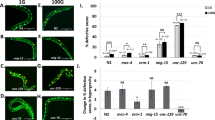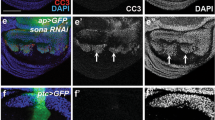Abstract
The goal of this study was to find genes that encode cytoskeletal proteins that are potential candidates for the role of triggers in cell mechanosensitivity in the fruit fly. Centrifugation was used to simulate the hypergravity effects (2g group); the constantly changing orientation of the larvae in the gravity field was performed in order to simulate the effects of microgravity (0g group) for 1.5, 6, 12 and 24 h. mRNA levels of different genes that encode the components of both tubulin and actin cytoskeleton were assessed by qRT-PCR. In the 0g group the mRNA levels of beta-tubulin and Msps were reduced after 1.5 h of the exposure and remained unchanged until 12 h, while they exceeded the control level after 24 h. The mRNA level of chaperonin containing T-complex 1 polypeptide subunits recovered earlier: after 6 and 12 h of the microgravity exposure. At the same time, the hypergravity effect led to more significant changes in the mRNA level of TCP1 complex components compared with those of tubulin and Msps. The mRNA level of beta-actin isoforms under micro- and hypergravity was decreased up to 12 h of the exposure, however, it remained reduced under microgravity conditions, while it recovered (Act87E) and even exceeded (Act57B) the reference level under hypergravity conditions. The mRNA level of supervillin was almost unchanged. Under microgravity conditions the mRNA level of fimbrin was decreased (it recovered by the 24 h time point), while the mRNA level of alpha-actinin was significantly increased by the 12 h time point of the exposure and after 24 h it was reduced to the control level. In contrast, under hypergravity conditions the mRNA level of fimbrin initially increased, and after 24 h it dropped below the control, while the mRNA level of alpha-actinin was significantly reduced, and after 24 h it was higher than the reference level. Similar results were obtained earlier in the experiments in rodents, but similar dynamics were observed for alpha-actinin isoforms 1 and 4, although no changes were observed for fimbrin. Since Drosophila melanogaster has no alpha-actinin isoform 4, it is hypothesized that its role in the cell is played by fimbrin.
Similar content being viewed by others
References
N. Dubinin and E. Vaulina, Life Sci. Space Res. 14, 47 (1976).
M. Ross, Adv. Space Res. 4, 305 (1984).
M. G. Tairbekov, V. Klimovitskii, and V. S. Oganov, Izv. Akad. Nauk, Ser. Biol. 5, 517 (1997).
G. Albrecht-Buehler, ASGSB Bull. 5 (2), 3 (1992).
A. Cogoli, J. Gravit. Physiol. 3 (1), 1 (1996).
S. J. Pardo, M. J. Patel, M. C. Sykes, et al., Am. J. Physiol. Cell Physiol. 288 (6), C1211 (2005).
J. G. Gershovich, N. A. Konstantinova, P. M. Gershovich, and L. B. Buravkova, J. Grav. Physiol. 14 (1), 133 (2007).
L. B. Buravkova, Yu. A. Romanov, N. A. Konstantinova, et al., Acta Astronaut. 63, 603 (2008).
P. M. Gershovich, J. G. Gershovich, and L. B. Buravkova, J. Grav. Physiol. 15 (1), 203 (2008).
D. Sakar, T. Nagaya, K. Koga, and H. Seo, Cells Environ. Med. 43 (1), 22 (1999).
B. M. Uva, M. A. Masini, M. Sturla, et al., Brain Res. 934, 132 (2002).
S. Gaboyard, M. P. Blachard, B. T. Travo, et al., NeuroReport 13 (16), 2139 (2002).
P. A. Plett, R. Abonour, S. M. Frankovitz, and C. M. Orschell, Exp. Hematol. 32, 773 (2004).
M. A. Kacena, P. Todd, and W. J. Landis, In Vitro Cell Dev. Biol.–Animal 39 (10), 454 (2004).
S. J. Crawford-Young, Int. J. Dev. Biol. 50 (2–3), 183 (2006).
H. Schatten, M. L. Lewis, and A. Chakrabari, Acta Astronaut. 49 (3–10), 399 (2001).
M. Zayzafoon, W. E. Gathings, and J. M. McDonald, Endocrinology 145 (5), 2421 (2004).
V. E. Meyers, M. Zayzafoon, S. R. Gonda, et al., J. Cell Biochem. 93 (4), 697 (2004).
V. E. Meyers, M. Zayzafoon, J. T. Douglas, and J. M. McDonald, J. Bone Miner. Res. 20 (10), 1858 (2005).
Z. Q. Dai, R. Wang, S. K. Ling, et al., Cell Prolif. 40 (5), 671 (2007).
Z. Pan, J. Yang, C. Guo, et al., Stem Cell Dev. 17 (4), 795 (2008).
I. V. Ogneva, J. Biomed. Biotechnol. 2013, Article ID 598461 (2013).
I. V. Ogneva, N. S. Biryukov, T. A. Leinsoo, and I. M. Larina, PLOS ONE 9 (4), e96395 (2014).
I. V. Ogneva, M. V. Maximova, and I. M. Larina, J. Appl. Physiol. 116 (10), 1315 (2014).
I. V. Ogneva, V. Gnyubkin, N. Laroche, et al., J. Appl. Physiol. 118, 613 (2015).
I. V. Ogneva and N. S. Biryukov, PLOS ONE 11 (4), e0153650 (2016).
K. J. Livak and T. D. Schmittgen, Methods 25, 402 (2001).
L. Cassimeris and J. Morabito, Mol. Biol. Cell. 15, 1580 (2004).
F. Gergely, V. M. Draviam, and J. W. Raff, Genes Dev. 17, 336 (2013).
K. M. Knee, O. A. Sergeeva, and J. A. King, Cell Stress Chaperones 18, 137 (2013).
M. B. Yaffe, G. W. Farr, D. Miklos, et al., Nature 358, 245 (1992).
S. Yokota, H. Yanagi, T. Yura, and H. Kubota, Eur. J. Biochem, 268, 4664 (2001).
K.-A. Won, R. J. Schumacher, G. W. Farr, et al., Mol. Cell Biol. 18 (12), 7584 (1998).
J. L. Crowley, T. C. Smith, Z. Fang, et al., Mol. Biol. Cell 20 (3), 948 (2009).
K. Matsushima, M. Shiroo, H. F. Kung, and T. D. Copeland, Biochemistry 27, 3765 (1988).
B. Janji, A. Giganti, V. De Corte, et al., J. Cell Sci. 119, 1947 (2006).
S. Goffart, A. Franko, Ch. S. Clemen, and R. J. Wiesner, Curr. Genet. 49, 125 (2006).
Author information
Authors and Affiliations
Corresponding author
Additional information
Original Russian Text © M.S. Kupriyanova, I.V. Ogneva, 2017, published in Biofizika, 2017, Vol. 62, No. 2, pp. 355–363.
Rights and permissions
About this article
Cite this article
Kupriyanova, M.S., Ogneva, I.V. Analysis of the expression levels of genes that encode cytoskeletal proteins in Drosophila melanogaster larvae during micro- and hypergravity effect simulations of different durations. BIOPHYSICS 62, 278–285 (2017). https://doi.org/10.1134/S0006350917020129
Received:
Accepted:
Published:
Issue Date:
DOI: https://doi.org/10.1134/S0006350917020129




